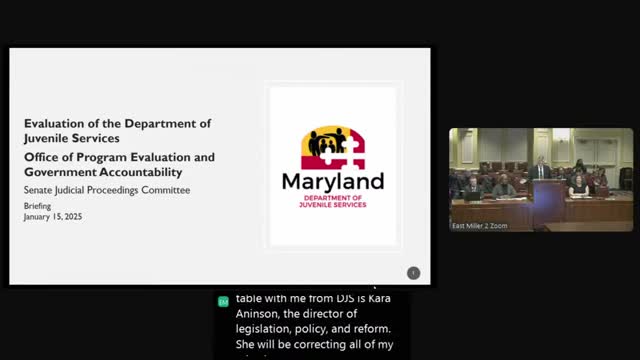Maryland launches Thrive Academy to combat youth gun violence and expand community services
January 15, 2025 | Judicial Proceedings Committee, SENATE, SENATE, Committees, Legislative, Maryland
This article was created by AI summarizing key points discussed. AI makes mistakes, so for full details and context, please refer to the video of the full meeting. Please report any errors so we can fix them. Report an error »

In a pivotal meeting on January 15, 2025, Maryland's JPR Committee spotlighted significant reforms aimed at revitalizing community resources for youth, particularly in response to alarming rates of gun violence. Assistant Secretary of Community Resources, Maisha Davis, and Dr. Aaron Betzinger from the University of Maryland, presented a comprehensive plan to address the gaps in services that have persisted over the past decade.
Davis revealed that the Department of Juvenile Services (DJS) had returned $134 million to the general fund instead of investing in essential services for young people. This alarming trend prompted immediate action from Governor Moore, leading to the establishment of a new position focused solely on community-based services. The DJS has since secured an $850,000 federal grant to conduct a thorough assessment of service gaps across Maryland's diverse counties.
One of the standout initiatives discussed was the Thrive Academy, designed to support youth at risk of gun violence. Launched with an initial $2.4 million allocation from the American Rescue Plan Act, the program aims to provide intensive support, including life coaching, job opportunities, and trauma therapy. Notably, only 2% of participants in the first year were victims of gun violence, indicating the program's potential effectiveness.
Additionally, the meeting addressed the urgent need for tailored services for girls within the juvenile system. A request for proposals is set to be issued soon, aiming to create a comprehensive continuum of care specifically for young women.
Workforce development also emerged as a critical focus, with plans to enhance job readiness programs for youth in DJS custody. Partnerships with local workforce boards and initiatives like the Youth Opportunities to Learn Occupations (YOLO) program are set to provide practical skills and employment opportunities.
The committee's discussions underscored a commitment to transforming Maryland's approach to youth services, with a clear emphasis on community engagement and targeted support. As these initiatives roll out, stakeholders are hopeful for a significant reduction in youth involvement in gun violence and improved outcomes for at-risk populations.
Davis revealed that the Department of Juvenile Services (DJS) had returned $134 million to the general fund instead of investing in essential services for young people. This alarming trend prompted immediate action from Governor Moore, leading to the establishment of a new position focused solely on community-based services. The DJS has since secured an $850,000 federal grant to conduct a thorough assessment of service gaps across Maryland's diverse counties.
One of the standout initiatives discussed was the Thrive Academy, designed to support youth at risk of gun violence. Launched with an initial $2.4 million allocation from the American Rescue Plan Act, the program aims to provide intensive support, including life coaching, job opportunities, and trauma therapy. Notably, only 2% of participants in the first year were victims of gun violence, indicating the program's potential effectiveness.
Additionally, the meeting addressed the urgent need for tailored services for girls within the juvenile system. A request for proposals is set to be issued soon, aiming to create a comprehensive continuum of care specifically for young women.
Workforce development also emerged as a critical focus, with plans to enhance job readiness programs for youth in DJS custody. Partnerships with local workforce boards and initiatives like the Youth Opportunities to Learn Occupations (YOLO) program are set to provide practical skills and employment opportunities.
The committee's discussions underscored a commitment to transforming Maryland's approach to youth services, with a clear emphasis on community engagement and targeted support. As these initiatives roll out, stakeholders are hopeful for a significant reduction in youth involvement in gun violence and improved outcomes for at-risk populations.
View full meeting
This article is based on a recent meeting—watch the full video and explore the complete transcript for deeper insights into the discussion.
View full meeting
